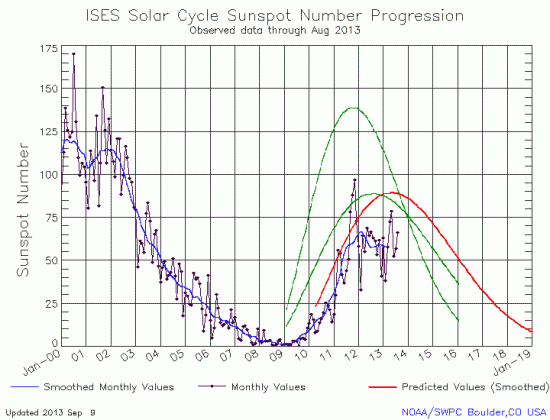“The face of the sun is nearly blank.”
Today NOAA posted its monthly update of the solar cycle, and as I do every month, I am posting it here, with annotations.
Before we take a look at that, however, there is other climate news that is apropos. The Daily Mail in the UK put out an entertaining article on Saturday with the headline “And now it’s global COOLING! Record return of Arctic ice cap as it grows by 60% in a year.”
The article is entertaining because, after illustrating the ice-cap’s recovery this year, it then notes the 2007 prediction by global warming climate scientists that the Arctic Ocean would be “ice-free” by 2013. If this isn’t a good example of the dangers of crying wolf, I don’t know what is.
I should emphasize that the ice-cap recovery this year does not prove that global warming has ceased. A look at this graph from satellite data shows that even though the Arctic icecap has recovered, it is still remains small when compared to the past few decades. The increase this year might only be a blip, or it could be indicating a new trend. We won’t really know for another five years, if then.
The article is also entertaining because it outlines the confusion that is right now going on behind the scenes at the IPCC. The next IPCC report is scheduled to come out next month, but no one agrees with its conclusions because it apparently ignores or minimizes the approximately fifteen year pause in warming that has now been documented since the late-1990s.
In its draft report, the IPCC says it is ‘95 per cent confident’ that global warming has been caused by humans – up from 90 per cent in 2007. This claim is already hotly disputed. US climate expert Professor Judith Curry said last night: ‘In fact, the uncertainty is getting bigger. It’s now clear the models are way too sensitive to carbon dioxide. I cannot see any basis for the IPCC increasing its confidence level.’ [emphasis mine]
It appears that scientists and governments are demanding approximately 1500 changes to the IPCC draft, which suggests its release will be delayed significantly.
Meanwhile, the Sun continues its lackluster and weak solar maximum.

The graph above has been modified to show the predictions of the solar science community. The green curves show the community’s two original predictions from April 2007, with half the scientists predicting a very strong maximum and half predicting a weak one. The red curve is their revised May 2009 prediction.
The Sun showed a slight increase in sunspots in August, apparently continuing the predicted second peak in this solar maximum. The numbers were not very high, however, which suggests that this second peak is now winding down.
We have several other indications that the solar maximum is now ending. The first is the source of the quote for this post’s title. At spaceweather.com today they noted how blank the Sun is at this moment. It has two small sunspots, but this appears to be the blankest the Sun has been since August of 2011, the last time the Sun’s face was completely devoid of any sunspots.
Another indicator that the solar maximum is ending is that the solar scientists at the Marshall Space Flight Center, led by solar scientist David Hathaway, have once again lowered their prediction for the solar maximum, dropping the predicted sunspot number peak from 67 to 66.
They also have been predicting that this peak would occur in the summer of 2013, which means that they have made this change after it happened. I would say this is par for the course for this crew, as they have repeatedly changed their prediction for the maximum over the past two years, making that prediction practically worthless in my eyes.
Either way, all these indicators suggest that the second peak is now ending and that we are about to watch as the Sun ramps down to a new minimum.
On Christmas Eve 1968 three Americans became the first humans to visit another world. What they did to celebrate was unexpected and profound, and will be remembered throughout all human history. Genesis: the Story of Apollo 8, Robert Zimmerman's classic history of humanity's first journey to another world, tells that story, and it is now available as both an ebook and an audiobook, both with a foreword by Valerie Anders and a new introduction by Robert Zimmerman.
The print edition can be purchased at Amazon or from any other book seller. If you want an autographed copy the price is $60 for the hardback and $45 for the paperback, plus $8 shipping for each. Go here for purchasing details. The ebook is available everywhere for $5.99 (before discount) at amazon, or direct from my ebook publisher, ebookit. If you buy it from ebookit you don't support the big tech companies and the author gets a bigger cut much sooner.
The audiobook is also available at all these vendors, and is also free with a 30-day trial membership to Audible.
"Not simply about one mission, [Genesis] is also the history of America's quest for the moon... Zimmerman has done a masterful job of tying disparate events together into a solid account of one of America's greatest human triumphs."--San Antonio Express-News


There should be a term for changing the prediction after the events have already occured because it isn’t a prediction at that point. Maybe postdiction?
Statistically none of the predictions meets a 95% confidence interval for predictions. Their predictions are useless. The IPCC climate models have even greater error…. 50% or even 100% on predicted warming, no?